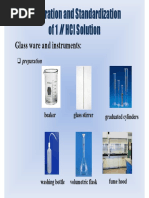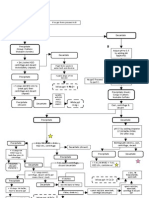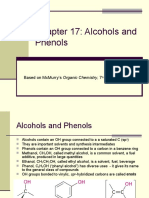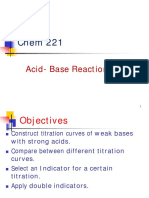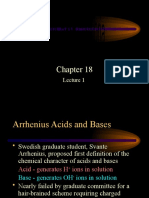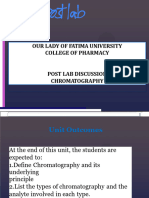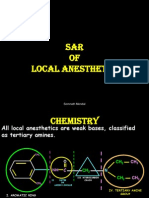5 With Notes PDF
5 With Notes PDF
Uploaded by
Kimberley Anne SeeCopyright:
Available Formats
5 With Notes PDF
5 With Notes PDF
Uploaded by
Kimberley Anne SeeOriginal Title
Copyright
Available Formats
Share this document
Did you find this document useful?
Is this content inappropriate?
Copyright:
Available Formats
5 With Notes PDF
5 With Notes PDF
Uploaded by
Kimberley Anne SeeCopyright:
Available Formats
EXPERIMENT 5: REACTIONS OF THE HYDROGEN SULFIDE GROUP
5-1 5-1a Reactions with Hydrogen Sulfide 5-1b Solubility in Na2S
Ions Formula Color & Nature reagent
Pb+2 PbS black insoluble
dark-brown or
Bi+3 Bi2S3 insoluble
brownish-black
Cu+2 CuS black insoluble
Cd+2 CdS yellow insoluble
HgS white yellow
Generally. the precipitate is
insoluble in water, hot
brown black
(initially a white precipitate of Na2HgS2
dilute nitric acid, alkali
mercury(II) chlorosulphide soluble colorless soln
hydroxides, or (colourless)
Hg+2 forms, which reacts with (sodium sulphide (2M) dissolves
ammonium sulphide
further amounts of hydrogen the precipitate when the complex
sulphide and finally a black ion is formed)
Aqua regia (1:3 HNO3 and
conc H2SO4) dissolves the precipitate of mercury(II)
precipitate sulphide is formed)
Sb2S3
(The precipitate is soluble in orange or reddish- Na3SbS4
Sb+3
warm concentrated orange soluble colorless soln
hydrochloric acid)
As2S3
(The precipitate is insoluble
in concentrated
hydrochloric acid Na3AsS4
As+3 yellow
(distinction and method of soluble colorless soln
separation from Sb2S3 and
SnS2), but dissolves in hot
concentrated nitric acid)
Na2SnS3
Sn+2 SnS light-brown
soluble colorless soln
Na2SnS3
Sn+4 SnS2 yellow
soluble colorless soln
Notes:
Cations of the second group are traditionally divided into two sub-groups; the copper sub-group and the arsenic sub-
group. The basis of this division is the solubility of the sulphide precipitates in ammonium polysulphide. While sulphides
of the copper sub-group are insoluble in this reagent, those of the arsenic sub-group do dissolve with the formation of
thiosalts
The chlorides, nitrates, and sulphates of the cations of the copper subgroup are quite soluble in water. The sulphides,
hydroxides, and carbonates are insoluble. Some of the cations of the copper sub-group (mercury (II), copper (II), and
cadmium (II) tend to form complexes (ammonia, cyanide ions, etc.). According to Gilreath (1954), these cations exhibit
basic properties hence forming insoluble precipitate upon the addition of KOH.
The arsenic sub-group consists of the ions arsenic (III), arsenic (V), antimony (III), antimony (V), tin (II) and tin (IV). These
ions have amphoteric character: their oxides form salts both with acids and bases (Vogel, 1996). According to Gilreath
(1954), these cations exhibit acidic properties hence forming soluble precipitate upon the addition of KOH
Confirmatory TESTS
Ions Reagents Formula Color & Nature
a) K2Cr04 PbCrO4 yellow
5-2 Pb+2
b) excess NaOH Na2PbO2 or Pb(OH)4-2 yellow soln
5-3 Bi+3
BiO
Bismuth is converted first into
In the presence of
the hydroxide form (Bi(OH)3)
bismuth the reaction is
upon addition of ammonia, Na2SnO2 black
accelerated with stannite
while cupric and cadmium in
ion; hence bismuth is
the ammonia complex form
precipitated
(Cu(NH3)42+ and Cd(NH3)42+)
5-4 Cu+2 a) K4Fe(CN)6 Cu2Fe(CN)6 amorphous reddish-
(remember: brown
ferrOcyanide) (insoluble in dilute acids)
b) NH4OH Cu(OH)NO3 green basic salt
Cu(NH3)4+2 or
c) excess NH4OH blue soln
Cu(NH3)4(OH)2
5-5 Cd+2 K4Fe(CN)6 Cd2Fe(CN)6 white
Ions Reagents Formula Color & Nature
white gray
(when added in moderate
amounts: white, silky
precipitate of mercury(I)
Hg2Cl2 HgO
chloride (calomel); If more
(only stannous ion will
a) SnCl2 reagent is added, mercury(I)
give the characteristic
chloride is further reduced
result for mercuric ion)
and black
5-6 Hg+2 precipitate of mercury is
formed)
Disproportionation
b) KI HgI2 scarlet red
soluble colorless soln
c) excess KI K2HgI4 or HgI4-2
(formation of complex)
Hg Silvery white deposit
d) copper coin (reduces mercury(II) ions
(Amalgam)
to the copper metal)
black
(formation of Sn-Ag couple
a) Ag coin + Tin SbO
5-7 Sb+3 hence formation of antimony
metal)
b) NaOBr --- insoluble
colorless gas +
5-8 As+3 NaOH, Al metal, AgNO3 AsH3 (arsine gas) + AgO
black
Hg2Cl2 HgO
+2
5-9 Sn HgCl2 Disproportionation white gray
reaction
colorless soln
a) Mg metal + HCl Sn+2 (converts the chlorstannate
to the stannous form)
Sn+4
Hg2Cl2 HgO
b) HgCl2 Disproportionation white gray
reaction
Ref: Vogel, A. I. (1996). Vogels Qualitative Inorganic Analysis.
Gilreath, E.S. (1954). Qualitative Analysis using Semi micro Methods.
You might also like
- Pharmaceutical Chemistry Answer Key (PINK PACOP)Document20 pagesPharmaceutical Chemistry Answer Key (PINK PACOP)BRYAN BALDOMERONo ratings yet
- EnterobacteriaceaeDocument35 pagesEnterobacteriaceaeFaisal AbbasNo ratings yet
- Lab 4 - Spinach and TLCDocument7 pagesLab 4 - Spinach and TLCLim ZjianNo ratings yet
- Preparation 19Document3 pagesPreparation 19Kimberley Anne See100% (1)
- Strep and EnterococciDocument64 pagesStrep and EnterococciJamil Muqtadir BhattiNo ratings yet
- Topical AgentsDocument5 pagesTopical AgentsFemina Argonza100% (1)
- PharmAnal 5Document22 pagesPharmAnal 5Aaron Jhulian SimbitNo ratings yet
- Non-Communicable Disease & Nutrition-1Document21 pagesNon-Communicable Disease & Nutrition-1ANGELICA FRANSCINE GOMEZNo ratings yet
- IPS - Physical Pharmacy SC Presentation 202324Document476 pagesIPS - Physical Pharmacy SC Presentation 202324DUEÑAS, MARIELNo ratings yet
- Chapter 2 Pharmaceutical Aids and NecessitiesDocument11 pagesChapter 2 Pharmaceutical Aids and NecessitiesZarah Pauline Jimenez100% (2)
- InformaticsDocument28 pagesInformaticsLynette EvangelistaNo ratings yet
- Pharchem LecDocument15 pagesPharchem LecNinna San Juan100% (1)
- Phar Chem 1 OBTLDocument6 pagesPhar Chem 1 OBTLtallulaNo ratings yet
- Cations Separation ExpDocument53 pagesCations Separation ExpDrReh E. AzoozNo ratings yet
- PharmChem-1 Lab Exp#01 - Analysis of Group I CationsDocument3 pagesPharmChem-1 Lab Exp#01 - Analysis of Group I CationsdavenNo ratings yet
- Introduction To CATION AnalysisDocument18 pagesIntroduction To CATION AnalysisJen MaramionNo ratings yet
- Qualitative Analysis of CationsDocument0 pagesQualitative Analysis of CationsKaran SaxenaNo ratings yet
- Handout For Qualitative AnalysisDocument9 pagesHandout For Qualitative AnalysisJarvin TanNo ratings yet
- TOXICOLOGY (Shortened) (2021)Document66 pagesTOXICOLOGY (Shortened) (2021)Joel SaluNo ratings yet
- Assay of Aspirin Tablets PDFDocument14 pagesAssay of Aspirin Tablets PDFTariq Al-shamiry71% (7)
- Chemistry Practical Test Guide For Cations and AnionsDocument2 pagesChemistry Practical Test Guide For Cations and Anionsansherina2100% (1)
- Standardization of HCL SolutionDocument12 pagesStandardization of HCL SolutionPranav KulkarniNo ratings yet
- Classification Tests For Carboxylic Acid and DerivativesDocument32 pagesClassification Tests For Carboxylic Acid and DerivativesRaizane Sky PalecNo ratings yet
- PHA611 LAB-Group4 Lab ReportDocument2 pagesPHA611 LAB-Group4 Lab ReportAcuCJamNo ratings yet
- Chap 04 Acids and BasesDocument22 pagesChap 04 Acids and BasesavNo ratings yet
- Solubility and Simultaneous Equilibria: Chemistry: The Molecular Nature of Matter, 6EDocument59 pagesSolubility and Simultaneous Equilibria: Chemistry: The Molecular Nature of Matter, 6EEriani WulandariNo ratings yet
- Bot Lab DataDocument1 pageBot Lab DataBillQueNo ratings yet
- Post Lab Qc1 2019Document42 pagesPost Lab Qc1 2019Frances SaludNo ratings yet
- Org Chem Lab ManualDocument62 pagesOrg Chem Lab ManualNowair TuanNo ratings yet
- Chem 18.1 Experiment 9 Qualitative Analysis - Separation and Identification of CationsDocument3 pagesChem 18.1 Experiment 9 Qualitative Analysis - Separation and Identification of Cationscarmina_guerreroNo ratings yet
- QUALITATIVE ANALYSIS OF GROUP II CATIONS Lab Chm360 2 FullDocument8 pagesQUALITATIVE ANALYSIS OF GROUP II CATIONS Lab Chm360 2 FullIsmi Fadli100% (3)
- S I L V E R: Reaction of Silver Group Reagent Formula Color and Nature HCLDocument1 pageS I L V E R: Reaction of Silver Group Reagent Formula Color and Nature HCLPharmaNo ratings yet
- Pharmaceutical Dosage Forms LABORATORY EXPERIMENTSDocument4 pagesPharmaceutical Dosage Forms LABORATORY EXPERIMENTSLA BriguelaNo ratings yet
- PHA611 - Unit 2 - Lesson 2 - Plant StemDocument9 pagesPHA611 - Unit 2 - Lesson 2 - Plant StemJonah Dane BautistaNo ratings yet
- CationsDocument6 pagesCationsPierce MoralesNo ratings yet
- Chapter 17: Alcohols and Phenols: Based On Mcmurry'S Organic Chemistry, 7 EditionDocument36 pagesChapter 17: Alcohols and Phenols: Based On Mcmurry'S Organic Chemistry, 7 EditionArk Olfato ParojinogNo ratings yet
- Test For GlycosidesDocument1 pageTest For GlycosidesGenevie27100% (1)
- Pharmaceutical Pharmaceutical (Medicinal) (Medicinal) Chemistry ChemistryDocument42 pagesPharmaceutical Pharmaceutical (Medicinal) (Medicinal) Chemistry ChemistryBandita DattaNo ratings yet
- Color Reactions Intact Protein (Gluten) Basic HydrolysisDocument6 pagesColor Reactions Intact Protein (Gluten) Basic HydrolysisJennifer CamaNo ratings yet
- Acid Base Titrations 11II PDFDocument35 pagesAcid Base Titrations 11II PDFŠĭlệncěIšmyPŕIdệNo ratings yet
- AcidBase Equilibrium Ch101EEEDocument343 pagesAcidBase Equilibrium Ch101EEEA. F. M. Mahfuzul KabirNo ratings yet
- Pha612 Lab Expt 6 Reactions and Analysis of The Ammonium Sulfide Group PDFDocument4 pagesPha612 Lab Expt 6 Reactions and Analysis of The Ammonium Sulfide Group PDFAmmonium ChlorideNo ratings yet
- AnionsDocument16 pagesAnionsMuna LasenaNo ratings yet
- Lesson 8Document11 pagesLesson 8KaizenNo ratings yet
- Xylem and Phloem - Lecture3Document21 pagesXylem and Phloem - Lecture3SamweliNo ratings yet
- Chromatography 22 23 1Document142 pagesChromatography 22 23 1Anna mae AaronNo ratings yet
- Melting Point NotesDocument7 pagesMelting Point Notesdfcgvh gvhbjNo ratings yet
- Medicinal Chemistry Unit I IntroductionDocument27 pagesMedicinal Chemistry Unit I IntroductionjalilaNo ratings yet
- Module 2 - Hydrocarbons and DerivativesDocument121 pagesModule 2 - Hydrocarbons and DerivativesLouise AnneNo ratings yet
- Non Aqueous Titrations by Gunja ChtaurvediDocument10 pagesNon Aqueous Titrations by Gunja ChtaurvediGunja Chaturvedi88% (8)
- Group 1 and 4 Cation AnalysisDocument26 pagesGroup 1 and 4 Cation Analysistwinkledreampoppies100% (1)
- Lecture 1 - Introduction To Secondary MetabolitesDocument36 pagesLecture 1 - Introduction To Secondary MetabolitesAlec LiuNo ratings yet
- Mariano Marcos State University: Pharmaceutical Botany With TaxonomyDocument7 pagesMariano Marcos State University: Pharmaceutical Botany With TaxonomyKaizenNo ratings yet
- Session 1.INTRODUCTION TO PHARMACEUTICAL ORGANIC CHEMISTRYDocument76 pagesSession 1.INTRODUCTION TO PHARMACEUTICAL ORGANIC CHEMISTRYboazcairo2No ratings yet
- Isolation and Color Reactions of ProteinsDocument4 pagesIsolation and Color Reactions of ProteinsRika MuhiNo ratings yet
- PHYANA Reviewer: Senses 18-22Document3 pagesPHYANA Reviewer: Senses 18-22Badeth100% (2)
- Applications of Chemical AnalysisDocument18 pagesApplications of Chemical AnalysisJames Anthony ParasNo ratings yet
- Chemistry of FlavonoidsDocument15 pagesChemistry of FlavonoidsSathish SizzyNo ratings yet
- Orgmed-3 2019Document91 pagesOrgmed-3 2019Joslin Roz Galilea100% (1)
- Local Anesthetics SarDocument15 pagesLocal Anesthetics SarSomnath MondalNo ratings yet
- CSEC Qualitative Analysis AnionsDocument8 pagesCSEC Qualitative Analysis Anions-Sabiraaa -No ratings yet
- Classification of Hospital - NewDocument1 pageClassification of Hospital - NewKimberley Anne SeeNo ratings yet
- MotionDocument23 pagesMotionKimberley Anne SeeNo ratings yet
- Take Home QuizDocument2 pagesTake Home QuizKimberley Anne SeeNo ratings yet
- Plating Media For Routine BacteriologyDocument5 pagesPlating Media For Routine BacteriologyKimberley Anne SeeNo ratings yet
- PharDose Lab PrelimsDocument8 pagesPharDose Lab PrelimsKimberley Anne SeeNo ratings yet
- Phardose Lab Prep 1-6Document4 pagesPhardose Lab Prep 1-6Kimberley Anne SeeNo ratings yet
- Halogen CompoundsDocument43 pagesHalogen CompoundsSai Sasivardhan GampaNo ratings yet
- Protective - Coating Lipids Biological WaxesDocument11 pagesProtective - Coating Lipids Biological WaxesLee DyaNo ratings yet
- Chirality QPDocument18 pagesChirality QPMohima SafaNo ratings yet
- JOTUN Tankguard Flexline Resistance List 19 Aug 21Document57 pagesJOTUN Tankguard Flexline Resistance List 19 Aug 21aleksandarshoylevNo ratings yet
- Etching of Polymeric Surfaces A ReviewDocument42 pagesEtching of Polymeric Surfaces A ReviewWilliams Marcel Caceres FerreiraNo ratings yet
- Oli InterfaceDocument240 pagesOli InterfaceMitko Kirov0% (1)
- IUPAC Naming - DPP 01 - Yakeen 2.0 2024 (Legend)Document3 pagesIUPAC Naming - DPP 01 - Yakeen 2.0 2024 (Legend)raj52013214No ratings yet
- 2.textile Dye Degradation Using Nano Zero Valent Iron - A ReviewDocument16 pages2.textile Dye Degradation Using Nano Zero Valent Iron - A ReviewNguyễn DiệpNo ratings yet
- Mahesh Janmanchi Aieee - 2010Document14 pagesMahesh Janmanchi Aieee - 2010janmanchiNo ratings yet
- Modification of Fat and OilDocument18 pagesModification of Fat and OilPawan ShresthaNo ratings yet
- PolymersDocument24 pagesPolymersGautam BalakrishnanNo ratings yet
- A Novel Process For Extracting Lithium From Lepidolite 2012 HydrometallurgyDocument6 pagesA Novel Process For Extracting Lithium From Lepidolite 2012 HydrometallurgyRose Olivares PinoNo ratings yet
- Chemistry A European J - 2020 - Schmidbaur - Permanganyl Fluoride A Brief History of The Molecule MnO3F and of Those WhoDocument12 pagesChemistry A European J - 2020 - Schmidbaur - Permanganyl Fluoride A Brief History of The Molecule MnO3F and of Those WhootpmairieuhihiNo ratings yet
- Astm B456Document11 pagesAstm B456TeodoroNo ratings yet
- CH 13Document33 pagesCH 13Twisha ViraniNo ratings yet
- Coordination Compounds & OrganometallicsDocument4 pagesCoordination Compounds & OrganometallicsUday Prakash SahuNo ratings yet
- 2024 Dse Chem Mock Exam 2Document10 pages2024 Dse Chem Mock Exam 2xiaotangdou1995No ratings yet
- Chemistry (Question Paper) MHT-CET 1Document17 pagesChemistry (Question Paper) MHT-CET 1THE FOOTBALL AREANANo ratings yet
- Zinc BallsDocument1 pageZinc BallsAreIf Cron BmxStreetNo ratings yet
- Water and Wastewater Analysis: PH, Acidity, Alkalinity and HardnessDocument44 pagesWater and Wastewater Analysis: PH, Acidity, Alkalinity and HardnessDr. Akepati Sivarami Reddy87% (15)
- Experiment 4Document4 pagesExperiment 4Jc Goh100% (2)
- Gastrointestinal Agents: Ana Marie L. Rubenicia, RPHDocument31 pagesGastrointestinal Agents: Ana Marie L. Rubenicia, RPHEmman AguilarNo ratings yet
- Water TreatmentDocument13 pagesWater TreatmentBayuNo ratings yet
- Formulating With Cationic EmulsifiersDocument16 pagesFormulating With Cationic Emulsifiersherfuentes100% (1)
- CN115463552A - Anti-Pollution Chlorine-Resistant Reverse Osmosis Membrane and Preparation Method and Application Thereof - Google PatentsDocument8 pagesCN115463552A - Anti-Pollution Chlorine-Resistant Reverse Osmosis Membrane and Preparation Method and Application Thereof - Google Patentssahar vahdatifarNo ratings yet
- 5 17 54 313Document15 pages5 17 54 313sanat kr pratiharNo ratings yet
- A Spectrophotometric Method For Determination of Chemical Oxygen Demand Using Home-Made ReagentsDocument7 pagesA Spectrophotometric Method For Determination of Chemical Oxygen Demand Using Home-Made ReagentsmiminNo ratings yet
- Semiconductor MaterialsDocument9 pagesSemiconductor Materialsmahmoud ghalyNo ratings yet
- Definitions - Topic 7 Organic Chemistry - AQA Chemistry GCSEDocument2 pagesDefinitions - Topic 7 Organic Chemistry - AQA Chemistry GCSEEkta KasanaNo ratings yet





















